Jiuzhaigou is a World Heritage Site and nature reserve on the edge of the Tibetan plateau in Northern Sichuan province in China. It takes its name, which means “Valley of Nine Villages” in English, from the nine Tibetan villages that are dotted along its length. It is arguably one of the most beautiful and scenic places on earth, but despite that, millions of Chinese make the long and somewhat arduous journey every year.
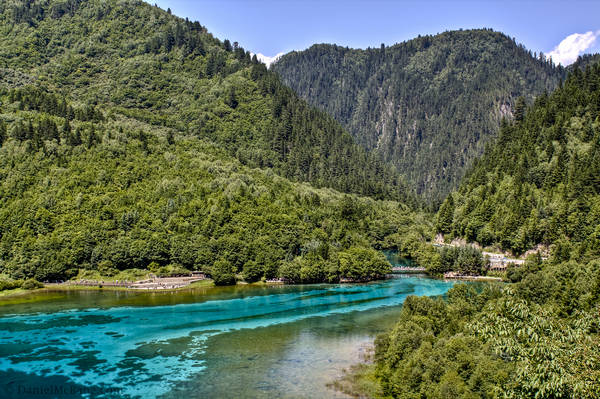
Five Flower Lake in Jiuzhaigou Nature Reserve in Sichuan, China
I say “despite”, because they don’t go there for the nature; in fact, all that natural beauty really just gets in the way, not to mention the 10 hour bus trip required to get there from Chengdu—and that’s ten hours assuming no rock-slides, which are fairly common in this area.
Add to that the relatively expensive flight or the 24 hour plus train ride needed to get to Chengdu from the east coast cities and you’ve got yourself quite a hassle. Of course most Chinese tourists travel as part of an organized tour package that takes care of everything, but at a cost. A very high cost.
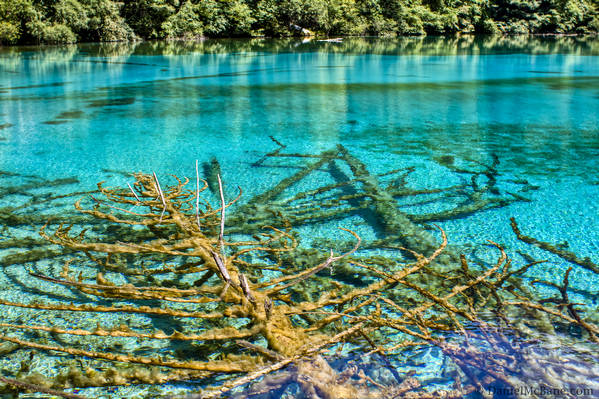
Ancient, fallen trees below the surface of Five Flower Lake
And of course the government takes their cut. As I mentioned in my post on Dunhuang, entrance fees to attractions popular with Chinese tourists have become extortionist and Jiuzhaigou is perhaps the most egregious example. Currently the cost of admission, including shuttle bus ticket (which you pretty much need) is 310 Yuan (just under US $50—to put that in perspective, the hourly wage for factory workers in southern China, the world’s factory floor, is around US $0.80).
And that’s the admission for one day. If you want to spend more time in the park, as most people do since it’s quite large, you have to pay the full price again the next day.
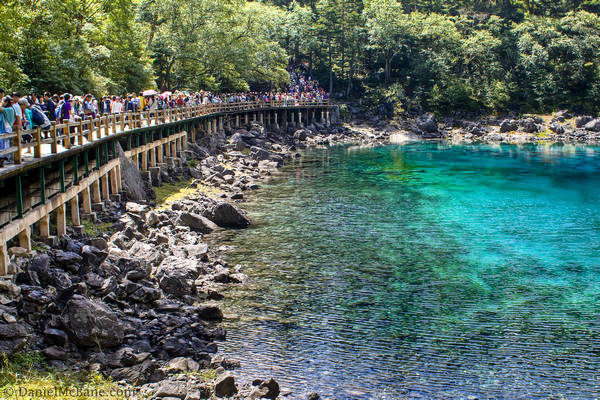
More people than the entire population of Canada enjoying Five Color Pond
So why do so many Chinese go through all this trouble when they don’t even really enjoy being there? In a word: lunacy status. In China, travel is a status symbol. I suppose it is everywhere, but nowhere near as much as in China; you go to a popular tourist attraction and take all the standard photos of yourself in front of the standard sights. Those photos serve as proof that you were able to afford that particular ‘status trip’.
And Jiuzhaigou is one of the best ‘status trips’ available. Anyone can (and does) go to the Great Wall or the Forbidden Palace, but the high costs in terms of both money and time make a trip to Jiuzhaigou a little more ‘high class’.
And the ultimate status boost comes from having wedding photos taken in the park (I’m sure at a cost I can’t even imagine). Anyone with wedding photos from Jiuzhaigou on their mantle is not only keeping up with the Joneses, or the Changs as it were, but has left them in the dust.
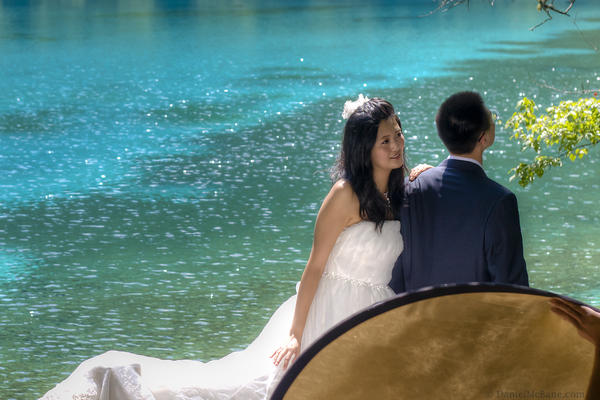
The envy of all their friends—who coincidentally have stopped answering their phones when the lucky couple calls
So what does all this mean for the Western tourist? It’s not good, I can tell you that much. I definitely still recommend going, because there really are very few places as beautiful as this valley, but you have to keep reminding yourself of that while you’re there.
Chinese tourists crowd the raised wooden walkways that run the length of the valley, but as anyone who’s been to China knows, they don’t just crowd a place. They push and shove their way along, shouting at volumes most people use to make themselves heard at a rock concert, throw trash everywhere and carry umbrellas.
And they wear ridiculous matching hats; although, to be fair, in Jiuzhaigou all the men wear ‘Tibetan hats’ instead of the standard ‘I’m with a tour group that collectively does not have the brain power required to keep from scattering all over the park without the aid of these spiffy, brightly colored hats’ hat.
Of course the ‘Tibetan hats’ are really just slightly altered cowboy hats that have never, in the long history of Tibet, been worn by a single Tibetan ever, excepting of course, those Tibetans employed at the park as a photo-op. But don’t tell that to any of the middle-aged Chinese men who sport them proudly in numerous photos, with their shirts rolled up to their chests to show off their guts (another status symbol termed the ‘boss belly’).
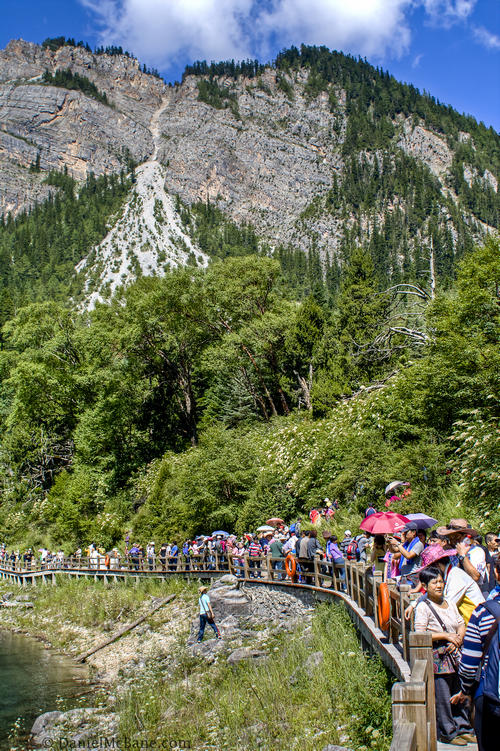
Beautiful scenery—and some people shoving their way through it
At one point I saw a little boy get elbowed off a walkway and dumped in one of the lakes. And then he stayed there; no one bothered to pay him any attention, much less take a few seconds to reach down and pull him out. No, after bursting into tears, he had to drag himself to the (luckily nearby) shore and out of the water.
If you’re wondering why I didn’t help, I was too busy pointing and laughing 20 meters away and it would have taken me an hour to reach him. I wish I had some pictures or a video of this whole thing, because it really was pretty shocking, but the kid disappeared in the crowd before I could catch him and toss him back in to recreate the incident.
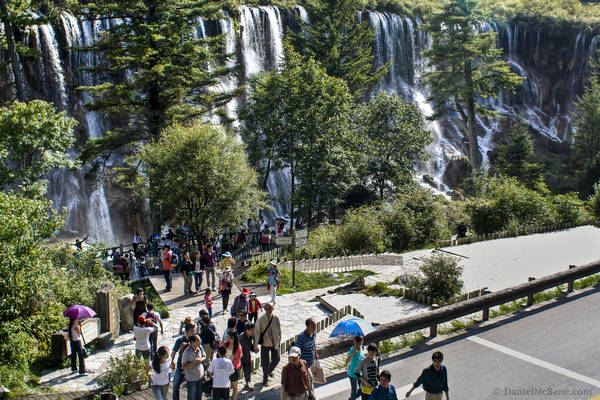
Nuorilang Falls—if you’re wondering where the crowds are, there’s a walkway down below
For me, though, the umbrellas are the worst of it all. Always the largest size available, taking up most of the space available on the narrow walkways, exactly at my eye level and constantly open and in use—in the rain they are needed to keep dry, in the sun to stay deathly pale and when it’s cloudy simply to take my eyes out.
Overall, you will have one of the most annoying days of your life in Jiuzhaigou, but you can get through it, if you stop every few meters to take a look around and remind yourself just how beautiful it all is.
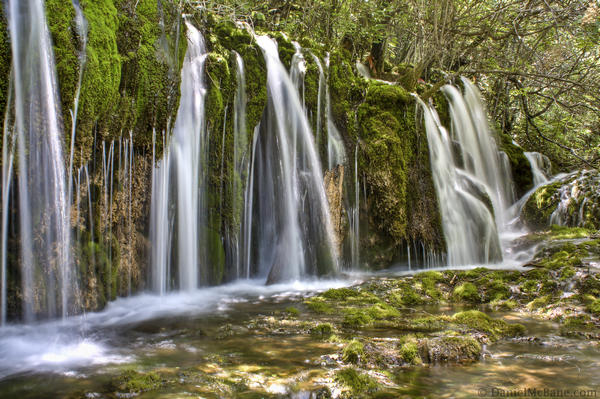
Not one of the famous waterfalls and thus relatively deserted
Luckily, you can also escape the crowds fairly easily. Chinese tour groups have a set path through the valley, taking a bus to the top, stopping to take photos at the famous sights there, then taking a bus down to the next sight. They continue riding the bus between sights until they reach the bottom of the valley.
This means that all the areas between famous sights are practically deserted and those areas saved my sanity. Of course you still see people, most of them Chinese even, but they’re the like-minded ones. The ones who came to enjoy the peace, tranquility and beauty of nature at its finest or the ones who are looking to take some photos away from the “Famous Photo Spot” signs that can generally be seen sticking out from any large gaggle of tourists.
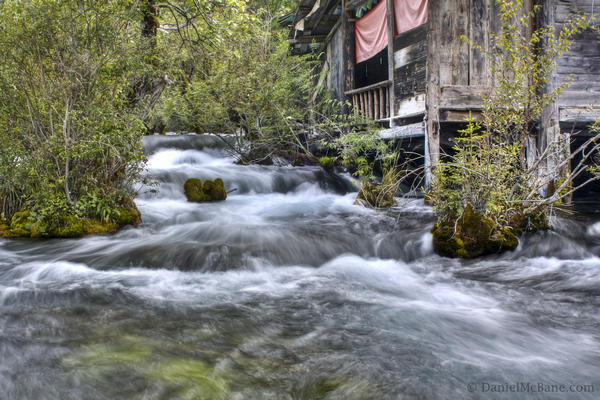
There really is water everywhere in this valley
If that’s not enough to keep you from losing your mind and barreling down the walkway like a bull in Pamplona, tossing tourists left and right into the water, just visit one of the ‘Tibetan villages.’ To call them that seems cruel actually, as these days they are little more than Tibetan-themed Chinese theme parks, but one look at the Tibetans who still live in the area will quickly bring home the fact that you really don’t have it so bad. And the fact that you can leave.
For further information on Jiuzhaigou, check out my travel guide, the valley’s Wikipedia page, or its entry on the UNESCO website.
I know exactly what you are taking about. Having been to Hua Shan and Huangshan in the past few weeks, I think I have become an expert at elbowing my way up or down trail. Some of the “hikers” have no business being on the trails, their only business is to take up as much room as possible and hold hands in the process. Argh! Rant over!
How big is your tripod and is it a pain to carry in that stampede?
I travel with a really small (but sturdy and heavy) tripod, so I practically have to lay on the ground to use it. That’s why I have almost no photos from the standard photo spots—I would have gotten trampled.
Such a beautiful place in Tibet, I have only imagined the rocky mountains in Tibet. This is very nice article for travel seekers, you have shared very beautiful pictures seems like a wonderful time spending place in holidays. Thank you for sharing